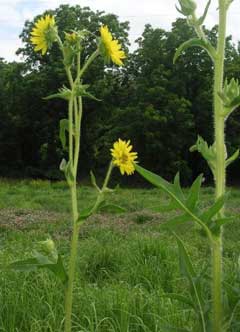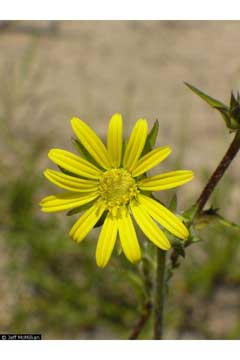 |
|
http://commons.wikimedia.org/wiki/User:Tout%C3%ADor%C3%AEx |
 |
| Jeff McMillian @ USDA-NRCS PLANTS Database |
Translate this page:
Summary
Physical Characteristics

 Silphium laciniatum is a PERENNIAL growing to 2 m (6ft) by 0.6 m (2ft in).
Silphium laciniatum is a PERENNIAL growing to 2 m (6ft) by 0.6 m (2ft in).
See above for USDA hardiness. It is hardy to UK zone 4. It is in flower from July to August, and the seeds ripen from August to September. The species is hermaphrodite (has both male and female organs) and is pollinated by Insects.
Suitable for: light (sandy), medium (loamy) and heavy (clay) soils. Suitable pH: mildly acid, neutral and basic (mildly alkaline) soils. It can grow in semi-shade (light woodland) or no shade. It prefers moist soil.
UK Hardiness Map
US Hardiness Map
Synonyms
Plant Habitats
Cultivated Beds;
Edible Uses
Edible Parts:
Edible Uses: Gum
A resin exudes naturally from the plant, and can also be obtained by incision[4]. It is an inexpensive substitute for mastic and is used as a chewing gum to sweeten the breath[4, 61, 105, 257]. It forms on the upper part of the flowering stem[183].
References More on Edible Uses
Medicinal Uses
Plants For A Future can not take any responsibility for any adverse effects from the use of plants. Always seek advice from a professional before using a plant medicinally.
Diuretic Emetic Expectorant Tonic Vermifuge
The resin obtained from the plant is diuretic[4, 61, 222]. It imparts a strong aromatic odour to urine[4]. A tea made from the roots is vermifuge and a tonic for general debility[4, 61, 222]. It is used as an expectorant in coughs and other pulmonary ailments[4]. A decoction of the smaller roots has been used as an emetic[257]. A tea made from the leaves is emetic, it has also been used in the treatment of coughs, lung ailments and asthma[222].
References More on Medicinal Uses
The Bookshop: Edible Plant Books
Our Latest books on Perennial Plants For Food Forests and Permaculture Gardens in paperback or digital formats.

Edible Tropical Plants
Food Forest Plants for Hotter Conditions: 250+ Plants For Tropical Food Forests & Permaculture Gardens.
More

Edible Temperate Plants
Plants for Your Food Forest: 500 Plants for Temperate Food Forests & Permaculture Gardens.
More

More Books
PFAF have eight books available in paperback and digital formats. Browse the shop for more information.
Shop Now
Other Uses
References More on Other Uses
Cultivation details
Industrial Crop: Hydrocarbon Management: Standard Wild Crop
Succeeds in any ordinary garden soil[1]. Prefers a deep moisture retentive moderately fertile soil that is not too nitrogen rich, in sun or dappled shade[200]. Prefers a shady position[200]. A very ornamental plant[1]. Leaves of young plants tip vertically and align themselves north to south to minimise exposure to the midday sun[200]. Plants have a deep and extensive root system which makes transplanting difficult[200]. The plant is heat tolerant in zones 9 through 5. (Plant Hardiness Zones show how well plants withstand cold winter temperatures.
Plant Heat Zones show when plants would start suffering from the heat.
The Plant Heat Zone map is based on the number of "heat days" experienced in a given area where the temperature climbs to over 86 degrees F (30°C).
At this temperature, many plants begin to suffer physiological damage. Heat Zones range from 1 (no heat days) to 12 (210 or more heat days).
For example Heat Zone. 11-1 indicates that the plant is heat tolerant in zones 11 through 1.) For polyculture design as well as the above-ground architecture (form - tree, shrub etc. and size shown above) information on the habit and root pattern is also useful and given here if available. The plant growth habit is a runner spreading indefinitely by rhizomes or stolons [1-2].
Carbon Farming
-
Industrial Crop: Hydrocarbon
Materials, chemicals and energy include bioplastics, rubber, biomass products gasoline, jet fuel, diesel, butane, propane, biogas. Plants are usually resprouting plants and saps.
-
Management: Standard
Plants grow to their standard height. Harvest fruit, seeds, or other products. Non-Destructive management systems.
-
Wild Crop
Some wild plants have strong historical or contemporary use. Although they are not cultivated crops, they may be wild-managed.
References Carbon Farming Information and Carbon Sequestration Information
Temperature Converter
Type a value in the Celsius field to convert the value to Fahrenheit:
Fahrenheit:
The PFAF Bookshop
Plants For A Future have a number of books available in paperback and digital form. Book titles include Edible Plants, Edible Perennials, Edible Trees,Edible Shrubs, Woodland Gardening, and Temperate Food Forest Plants. Our new book is Food Forest Plants For Hotter Conditions (Tropical and Sub-Tropical).
Shop Now
Plant Propagation
Seed - best sown as soon as it is ripe in a greenhouse[200]. Prick out the seedlings into individual pots as soon as they are large enough to handle and plant them out in the summer. Division in spring[188]. This is very difficult due to the deep and extensive root system.
Other Names
If available other names are mentioned here
Native Range
NORTHERN AMERICA: Canada, Ontario (south), United States, Indiana, Michigan, New York, Ohio, Pennsylvania, Illinois, Iowa, Kansas, Minnesota, Missouri, Nebraska, Oklahoma, South Dakota, Wisconsin, Alabama, Arkansas, Kentucky, Louisiana, Mississippi, Tennessee, New Mexico, Texas,
Weed Potential
Right plant wrong place. We are currently updating this section.
Please note that a plant may be invasive in one area but may not in your area so it's worth checking.
Conservation Status
IUCN Red List of Threatened Plants Status :

Growth: S = slow M = medium F = fast. Soil: L = light (sandy) M = medium H = heavy (clay). pH: A = acid N = neutral B = basic (alkaline). Shade: F = full shade S = semi-shade N = no shade. Moisture: D = dry M = Moist We = wet Wa = water.
Now available:
Food Forest Plants for Mediterranean Conditions
350+ Perennial Plants For Mediterranean and Drier Food Forests and Permaculture Gardens.
[Paperback and eBook]
This is the third in Plants For A Future's series of plant guides for food forests tailored to
specific climate zones. Following volumes on temperate and tropical ecosystems, this book focuses
on species suited to Mediterranean conditions—regions with hot, dry summers and cool, wet winters,
often facing the added challenge of climate change.
Read More
Expert comment
Author
L.
Botanical References
43200274
Links / References
For a list of references used on this page please go here
Readers comment
© 2010, Plants For A Future. Plants For A Future is a charitable company limited by guarantee, registered in England and Wales. Charity No. 1057719, Company No. 3204567.